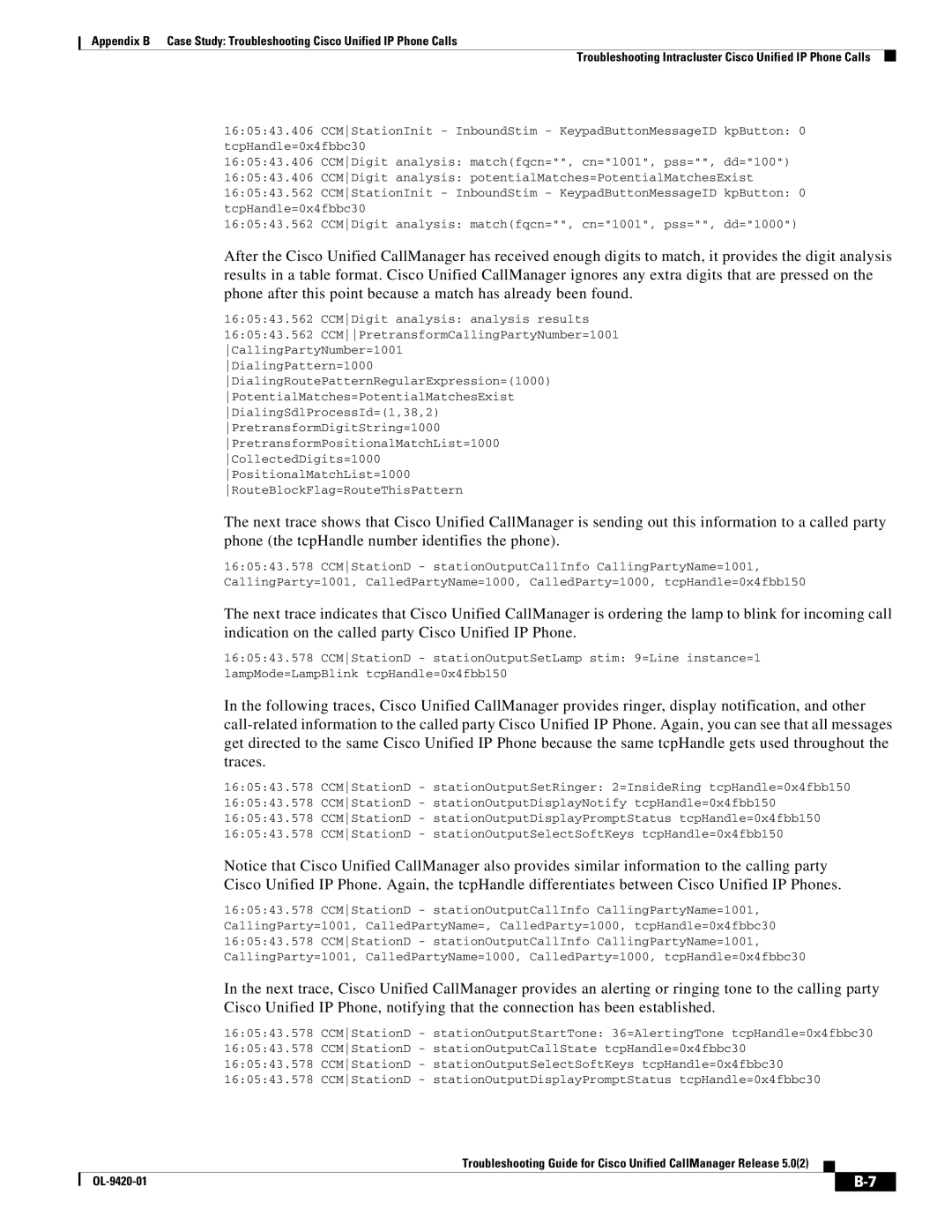
Appendix B Case Study: Troubleshooting Cisco Unified IP Phone Calls
Troubleshooting Intracluster Cisco Unified IP Phone Calls
16:05:43.406 CCMStationInit - InboundStim - KeypadButtonMessageID kpButton: 0 tcpHandle=0x4fbbc30
16:05:43.406 CCMDigit analysis: match(fqcn="", cn="1001", pss="", dd="100")
16:05:43.406 CCMDigit analysis: potentialMatches=PotentialMatchesExist
16:05:43.562 CCMStationInit - InboundStim - KeypadButtonMessageID kpButton: 0 tcpHandle=0x4fbbc30
16:05:43.562 CCMDigit analysis: match(fqcn="", cn="1001", pss="", dd="1000")
After the Cisco Unified CallManager has received enough digits to match, it provides the digit analysis results in a table format. Cisco Unified CallManager ignores any extra digits that are pressed on the phone after this point because a match has already been found.
16:05:43.562 CCMDigit analysis: analysis results 16:05:43.562 CCMPretransformCallingPartyNumber=1001 CallingPartyNumber=1001
DialingPattern=1000
DialingRoutePatternRegularExpression=(1000)
PotentialMatches=PotentialMatchesExist
DialingSdlProcessId=(1,38,2)
PretransformDigitString=1000
PretransformPositionalMatchList=1000
CollectedDigits=1000
PositionalMatchList=1000
RouteBlockFlag=RouteThisPattern
The next trace shows that Cisco Unified CallManager is sending out this information to a called party phone (the tcpHandle number identifies the phone).
16:05:43.578 CCMStationD - stationOutputCallInfo CallingPartyName=1001, CallingParty=1001, CalledPartyName=1000, CalledParty=1000, tcpHandle=0x4fbb150
The next trace indicates that Cisco Unified CallManager is ordering the lamp to blink for incoming call indication on the called party Cisco Unified IP Phone.
16:05:43.578 CCMStationD - stationOutputSetLamp stim: 9=Line instance=1 lampMode=LampBlink tcpHandle=0x4fbb150
In the following traces, Cisco Unified CallManager provides ringer, display notification, and other
16:05:43.578 CCMStationD - stationOutputSetRinger: 2=InsideRing tcpHandle=0x4fbb150 16:05:43.578 CCMStationD - stationOutputDisplayNotify tcpHandle=0x4fbb150 16:05:43.578 CCMStationD - stationOutputDisplayPromptStatus tcpHandle=0x4fbb150 16:05:43.578 CCMStationD - stationOutputSelectSoftKeys tcpHandle=0x4fbb150
Notice that Cisco Unified CallManager also provides similar information to the calling party Cisco Unified IP Phone. Again, the tcpHandle differentiates between Cisco Unified IP Phones.
16:05:43.578 CCMStationD - stationOutputCallInfo CallingPartyName=1001, CallingParty=1001, CalledPartyName=, CalledParty=1000, tcpHandle=0x4fbbc30 16:05:43.578 CCMStationD - stationOutputCallInfo CallingPartyName=1001, CallingParty=1001, CalledPartyName=1000, CalledParty=1000, tcpHandle=0x4fbbc30
In the next trace, Cisco Unified CallManager provides an alerting or ringing tone to the calling party Cisco Unified IP Phone, notifying that the connection has been established.
16:05:43.578 CCMStationD - stationOutputStartTone: 36=AlertingTone tcpHandle=0x4fbbc30 16:05:43.578 CCMStationD - stationOutputCallState tcpHandle=0x4fbbc30
16:05:43.578 CCMStationD - stationOutputSelectSoftKeys tcpHandle=0x4fbbc30 16:05:43.578 CCMStationD - stationOutputDisplayPromptStatus tcpHandle=0x4fbbc30
Troubleshooting Guide for Cisco Unified CallManager Release 5.0(2)
| ||
|
